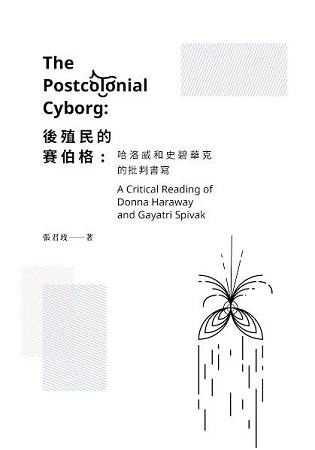本書從界線、批判、抵抗這三條交互纏繞的向度去貫穿哈洛威和史碧華克的思想,分別就知識的基礎、倫理的可能以及行動的方向,去釐清共同生活的多重意義。
導論勾勒了本書的問題意識與具體計劃。第二章檢視兩位學者的批判意象,每一個批判意象都同時是行動的意向,涉及了界線協商、衝突、呈現與體現的多重權力鬥爭。第三章和第四章分別深入檢視兩位思想家的批判方法論,及其深層的世界圖像與行動意義。第五章結論則指出,在兩位思想家看似各有領域的思考軸線中,可以找到共通的實踐取向分別展現在她們差異的發言位置。
這個共同基礎是蘊藏在她們批判方法論中的對於強權與現狀的抵抗。這樣的抵抗表現在很多層面,其中必然也涉及對界線的重新思考、跨越與打造,此為兩位思想家共同指出的當代倫理責任。同時,她們之間的差異所在依然重要,尤其是各自迥異的發言位置所揭示的故事、隱喻和矛盾。此外,在所有的閱讀計畫中,我們都必須去尋找並建構自己賴以生存、思考與行動的語言。
身為後殖民的賽伯格,島嶼破碎的主體性需要不斷的跨越與重構。
英文簡介:
This book discusses Donna Haraway’s and Gayatri Spivak’s theories from three interweaving dimensions of boundary, critique and resistance, and explores the meaning of living together in terms of the basis of knowledges, the possibility of ethics and the future of actions.
The introduction provides an outline of the book as a whole. The second chapter examines the critical images in Haraway’s and Spivak’s works. These images imply particular intentions of action and the relevant power struggles about boundary negotiations, conflicts, representations and embodiments. Chapter 3 and 4 investigate respectively Haraway’s and Spivak’s methodologies of critique, and the underlying world images and their agential significance. The conclusion chapter points out that these two thinkers share some common orientations based respectively on their different positions of enunciation.
Their common ground is the resistance to strong powers. The resistance is multifarious and inherent in their methodologies of critique, and involves rethinking, and reconstitution of boundaries. Their works point to the same ethical responsibility we face in the contemporary global world. However, their differences are as important as their common goals. Each in her own particular existential position of enunciation reveals unique stories, metaphors and contradictions. Meanwhile, we have to construct our own discourses in every reading project. It is only through these discourses we can begin to understand our own worldly existence, and to think and act for ourselves.
| FindBook |
|
有 1 項符合
後殖民的賽伯格:哈洛威和史碧華克的批判書寫的圖書 |
 |
$ 179 ~ 360 | 後殖民的賽伯格: 哈洛威和史碧華克的批判書寫
作者:張君玫 出版社:群學出版有限公司 出版日期:2016-07-09  共 9 筆 → 查價格、看圖書介紹 共 9 筆 → 查價格、看圖書介紹
|
|
|
伯格
圖書介紹 - 資料來源:博客來 評分:
圖書名稱:後殖民的賽伯格:哈洛威和史碧華克的批判書寫
內容簡介
目錄
序 理解「我們」的島嶼經驗 成令方
序 穿過詞語的黑暗去照亮 印卡
致謝辭
第一章 導論:島嶼書寫的一段理論旅程
第二章 界線/戒限:批判的意象與意向
第三章 哈洛威:跨界的抵抗辯證
第四章 史碧華克:解構的雙面受縛
第五章 結論:後殖民的賽伯格
參考書目
序 穿過詞語的黑暗去照亮 印卡
致謝辭
第一章 導論:島嶼書寫的一段理論旅程
第二章 界線/戒限:批判的意象與意向
第三章 哈洛威:跨界的抵抗辯證
第四章 史碧華克:解構的雙面受縛
第五章 結論:後殖民的賽伯格
參考書目
序
推薦序
理解「我們」的島嶼經驗
成令方
你/妳說你/妳是台灣人,你/妳愛台灣。你/妳理解「台灣人」嗎?我想你/妳若理解得越深刻,就越知道可以如何「愛」台灣了。
我來自中國移民家庭的背景,作為中產階級女性主義者,承受全球爆炸的商品資本主義資訊,參與凝聚台灣的認同,隨手使用多樣科技的日常生活,我的島嶼經驗是複數、混搭、矛盾、流動、位移、五味雜陳。我常自問,作為全球資本主義的生存者,我該如何在繽紛多彩的誘惑迷霧中,看到邊緣殘酷的現實與困境?做為社會人文的教師,我又如何與探索、渴求的青春心靈激盪出迴響,讓我們能跨越世代/性別/階級/族群的彼此看見?作為社會的改革者,我如何辭嚴色厲地批判,卻還能唱出悲憫疼惜的曲調?作為女性主義者,我如何洞視父權嚴密結構的限制,卻還能運用流動的權力在細縫中找到抵抗的能量與活水?這些問題不斷地在我的心中反覆思索,這應該是很多島嶼上生活的人們的共同經驗吧!
翻譯高手的君玫把史碧華克的後殖民文化批判理論巨作《後殖民理性批判》(2005)和哈洛威的後人類科技批判巨作《猿猴,賽伯格和女人》(2010)引介到華文世界,讓華文讀者可以一窺其深具啟發奧妙的論證。吸納融會了這二位學術巨靈的思想養分,君玫以台灣島嶼女人的立場,思考身為後殖民的主體,也是科技科學的主體,在這兩個並存的樣態與處境中來回對話思索,完成這本《後殖民的賽伯格》。
君玫討論史碧華克和哈洛威的思想,讓我特喜歡的是著重在她們批判與實踐的意義:「對我而言,這並非單純的所謂『理論應用』。實際上,我始終主張理論的動態思考並不是關於拿一個理論來應用到現實,而在於回歸到活生生的生存處境:誰在思考,在哪裡思考,如何思考,如何生活,如何在生活中思考,並在思考中改變生活。」君玫的書寫,讓我有故知新解茅塞頓開的喜悅。原來就是這樣,人可以生猛地活在分裂混雜的矛盾中,而且可以藉由不斷思考我們身處的界線/戒限,來批判,來抵抗,逐漸地我們生活在改變中。
這本書沿著三條交織的主軸「界線、批判、抵抗」帶領我們理解,耙梳史碧華克和哈洛威的思想。我認為跨界是重要的能力,可以讓我們看見彼此的差異,是實踐批判與抵抗的基礎,我想以生活中的例子來說明。
二〇一六年五二〇那天小英總統就職典禮,總統府外慶祝大會,最後全體觀禮者與蔡英文總統和陳建仁副總統合唱當年被政府視為宣揚台獨理念而被禁唱的《美麗島》。「原住民族青年陣線」則在臉書上吐槽,批評《美麗島》歌詞中仍展現漢民族中心主義:「從國民黨『大中國史觀』到民進黨『台灣人史觀』,原住民族跟著你們『篳路藍縷』,我們就『顛沛流離』;你說這是美麗島,啟的都是我們的山林」。
這首歌曾經凝聚了部份「台灣漢人」的認同,挑戰了「嚴懲台獨」的界線/戒限,但輕忽了「原住民主體認同」。換言之,島嶼人民在凝聚「認同」的過程形成了界線/戒限與界線/戒限之間的衝突與矛盾。日常生活中,我們可能接受某些主流的論述,而邊緣論述也呼喚著我們的邊緣生活經驗。史碧華克認為這些邊緣論述彼此是「不可化約的」,例如:「獨立建國」的論述不能凌駕於「多元成家」、「環保」或「動物權」論述之上,而是彼此同時並存彼此競逐。「不可化約的邊緣」,可以讓參與其中的個人認識其他身為邊緣、他者、從屬者、被壓迫者、被殖民者的處境。這樣可以擺脫容易造成分裂的「本質論」,理解認同的界線是可以隨著社會改變而轉移的,也因為有踏實的生活經驗為基礎,個人不會落入虛無主義。當每一個人看見彼此的生活處境,他/她就能培養出文化解釋的能力,也培養出對社會權力批判的能力。
要能夠看見,就需要有觀看的位置,觀看的人站在特定的物質位置上,採用特定的儀器、工具、組裝,透過具體的感知中介,例如:身體、概念、價值、影象,才得以完成(這裡就帶出哈洛威的「賽伯格」的意象)。例如:作為女人,女性主義論述經由視覺化的科技,書本、電影,號召出我的一些女性在父權體制壓迫下的經驗,讓我認知到父權的宰制與壓迫,也經由視覺化的科技,例如:紀錄片、書籍、電子郵件、臉書貼文,認識了勞動女性與慰安婦,讓我得以我的身體去想像勞動者的困境,體認日本殖民時代作為性奴隸的處境。逐漸地我理解作為中產女性與勞動女性生活經驗的界線/戒限,也對日本殖民體制有更深刻的理解。作為人文社會的教師,我在課堂中也不斷以此方式引導同學,去跨越世代、性別、族群與階級去看見其他的弱勢者。
這樣的知識用哈洛威的說法,是具有部分客觀性的處境知識(situated knowledges)。藉由處境知識的獲得,我們看到自己和他人都擁有多重認同與生活經驗,也理解多重認同彼此的界線/戒限,有了理解與體認,內在的謙虛逐漸發酵,就不會以某一論述去霸凌或化約另一論述。哈洛威建議,弱勢的團體可以透過彼此的親近性(affinity),而非認同來結盟。於是島嶼上邊緣弱勢的處境,逐漸成為部份的「我們」共同理解的處境。
要在島嶼上互相看見「我們」,除了上述的路徑外,哈洛威提出的賽伯格意象,可以讓我們更加意識到「我們」作為科技島的特色。哈洛威認為「賽伯格是我們的存有論」。戰後的台灣積極從農業社會轉向工業社會,政府投入大量的金錢與土地協助台塑發展石化工業,以及後來的電子科學園區。石化產品是每一個人從出生到死亡都會使用的,電子科技成為島嶼人民生活的必需品,加上近二十多年來人們常用的生物科技產品(例如:健康食品、醫療輔具、各類藥品),這是我們存在的客觀事實。我們就是賽伯格。然而,島嶼的經濟發展是建立在製造河川、土壤與空氣的污染之上,是建立在砍伐森林、改變河床、剝削自然之上,是建立在壓榨工程師、勞工的健康之上,是建立在過度醫療化之上。二十世紀中期逐漸沸騰的動物權論述指出,人類對待動物的方式完全否定動物生命的價值,這是最殘忍的事實。哈洛威批判獨尊人類的思想,指出一個改變的方向:人類的存在需要轉向理解人與非人(科技與動物)的關係。換言之,科技島嶼的住民需要思考科技發展與大自然的關係,放下以人獨尊的觀看位置,重新思索、批判,尋找永續生息之路,讓科技發展減少污染,無須過度破壞自然也無須過度壓榨參與的勞工。在過程中,每一個「我」逐漸改變,於是「我們」在改變中,這島嶼也逐漸在改變中。
當每一個台灣人能夠跨界看見其他生活在這島嶼上的弱勢者、動物、科技與我們的關係,當思想轉變成行動,這行動中必然產生一些批判與抵抗,於是在這轉動的能量中,我們每個人混搭的生活經驗與認同也擴展、越界、舊的矛盾消失在新的矛盾中。作為島嶼住民的「我們」,可以珍惜島嶼上的住民和多重行動者(包括人與動物、科技的關係)共構的世界,「我們」就更認識「台灣人」,更會愛台灣了。
作者現為高雄醫學大學性別研究所副教授
理解「我們」的島嶼經驗
成令方
你/妳說你/妳是台灣人,你/妳愛台灣。你/妳理解「台灣人」嗎?我想你/妳若理解得越深刻,就越知道可以如何「愛」台灣了。
我來自中國移民家庭的背景,作為中產階級女性主義者,承受全球爆炸的商品資本主義資訊,參與凝聚台灣的認同,隨手使用多樣科技的日常生活,我的島嶼經驗是複數、混搭、矛盾、流動、位移、五味雜陳。我常自問,作為全球資本主義的生存者,我該如何在繽紛多彩的誘惑迷霧中,看到邊緣殘酷的現實與困境?做為社會人文的教師,我又如何與探索、渴求的青春心靈激盪出迴響,讓我們能跨越世代/性別/階級/族群的彼此看見?作為社會的改革者,我如何辭嚴色厲地批判,卻還能唱出悲憫疼惜的曲調?作為女性主義者,我如何洞視父權嚴密結構的限制,卻還能運用流動的權力在細縫中找到抵抗的能量與活水?這些問題不斷地在我的心中反覆思索,這應該是很多島嶼上生活的人們的共同經驗吧!
翻譯高手的君玫把史碧華克的後殖民文化批判理論巨作《後殖民理性批判》(2005)和哈洛威的後人類科技批判巨作《猿猴,賽伯格和女人》(2010)引介到華文世界,讓華文讀者可以一窺其深具啟發奧妙的論證。吸納融會了這二位學術巨靈的思想養分,君玫以台灣島嶼女人的立場,思考身為後殖民的主體,也是科技科學的主體,在這兩個並存的樣態與處境中來回對話思索,完成這本《後殖民的賽伯格》。
君玫討論史碧華克和哈洛威的思想,讓我特喜歡的是著重在她們批判與實踐的意義:「對我而言,這並非單純的所謂『理論應用』。實際上,我始終主張理論的動態思考並不是關於拿一個理論來應用到現實,而在於回歸到活生生的生存處境:誰在思考,在哪裡思考,如何思考,如何生活,如何在生活中思考,並在思考中改變生活。」君玫的書寫,讓我有故知新解茅塞頓開的喜悅。原來就是這樣,人可以生猛地活在分裂混雜的矛盾中,而且可以藉由不斷思考我們身處的界線/戒限,來批判,來抵抗,逐漸地我們生活在改變中。
這本書沿著三條交織的主軸「界線、批判、抵抗」帶領我們理解,耙梳史碧華克和哈洛威的思想。我認為跨界是重要的能力,可以讓我們看見彼此的差異,是實踐批判與抵抗的基礎,我想以生活中的例子來說明。
二〇一六年五二〇那天小英總統就職典禮,總統府外慶祝大會,最後全體觀禮者與蔡英文總統和陳建仁副總統合唱當年被政府視為宣揚台獨理念而被禁唱的《美麗島》。「原住民族青年陣線」則在臉書上吐槽,批評《美麗島》歌詞中仍展現漢民族中心主義:「從國民黨『大中國史觀』到民進黨『台灣人史觀』,原住民族跟著你們『篳路藍縷』,我們就『顛沛流離』;你說這是美麗島,啟的都是我們的山林」。
這首歌曾經凝聚了部份「台灣漢人」的認同,挑戰了「嚴懲台獨」的界線/戒限,但輕忽了「原住民主體認同」。換言之,島嶼人民在凝聚「認同」的過程形成了界線/戒限與界線/戒限之間的衝突與矛盾。日常生活中,我們可能接受某些主流的論述,而邊緣論述也呼喚著我們的邊緣生活經驗。史碧華克認為這些邊緣論述彼此是「不可化約的」,例如:「獨立建國」的論述不能凌駕於「多元成家」、「環保」或「動物權」論述之上,而是彼此同時並存彼此競逐。「不可化約的邊緣」,可以讓參與其中的個人認識其他身為邊緣、他者、從屬者、被壓迫者、被殖民者的處境。這樣可以擺脫容易造成分裂的「本質論」,理解認同的界線是可以隨著社會改變而轉移的,也因為有踏實的生活經驗為基礎,個人不會落入虛無主義。當每一個人看見彼此的生活處境,他/她就能培養出文化解釋的能力,也培養出對社會權力批判的能力。
要能夠看見,就需要有觀看的位置,觀看的人站在特定的物質位置上,採用特定的儀器、工具、組裝,透過具體的感知中介,例如:身體、概念、價值、影象,才得以完成(這裡就帶出哈洛威的「賽伯格」的意象)。例如:作為女人,女性主義論述經由視覺化的科技,書本、電影,號召出我的一些女性在父權體制壓迫下的經驗,讓我認知到父權的宰制與壓迫,也經由視覺化的科技,例如:紀錄片、書籍、電子郵件、臉書貼文,認識了勞動女性與慰安婦,讓我得以我的身體去想像勞動者的困境,體認日本殖民時代作為性奴隸的處境。逐漸地我理解作為中產女性與勞動女性生活經驗的界線/戒限,也對日本殖民體制有更深刻的理解。作為人文社會的教師,我在課堂中也不斷以此方式引導同學,去跨越世代、性別、族群與階級去看見其他的弱勢者。
這樣的知識用哈洛威的說法,是具有部分客觀性的處境知識(situated knowledges)。藉由處境知識的獲得,我們看到自己和他人都擁有多重認同與生活經驗,也理解多重認同彼此的界線/戒限,有了理解與體認,內在的謙虛逐漸發酵,就不會以某一論述去霸凌或化約另一論述。哈洛威建議,弱勢的團體可以透過彼此的親近性(affinity),而非認同來結盟。於是島嶼上邊緣弱勢的處境,逐漸成為部份的「我們」共同理解的處境。
要在島嶼上互相看見「我們」,除了上述的路徑外,哈洛威提出的賽伯格意象,可以讓我們更加意識到「我們」作為科技島的特色。哈洛威認為「賽伯格是我們的存有論」。戰後的台灣積極從農業社會轉向工業社會,政府投入大量的金錢與土地協助台塑發展石化工業,以及後來的電子科學園區。石化產品是每一個人從出生到死亡都會使用的,電子科技成為島嶼人民生活的必需品,加上近二十多年來人們常用的生物科技產品(例如:健康食品、醫療輔具、各類藥品),這是我們存在的客觀事實。我們就是賽伯格。然而,島嶼的經濟發展是建立在製造河川、土壤與空氣的污染之上,是建立在砍伐森林、改變河床、剝削自然之上,是建立在壓榨工程師、勞工的健康之上,是建立在過度醫療化之上。二十世紀中期逐漸沸騰的動物權論述指出,人類對待動物的方式完全否定動物生命的價值,這是最殘忍的事實。哈洛威批判獨尊人類的思想,指出一個改變的方向:人類的存在需要轉向理解人與非人(科技與動物)的關係。換言之,科技島嶼的住民需要思考科技發展與大自然的關係,放下以人獨尊的觀看位置,重新思索、批判,尋找永續生息之路,讓科技發展減少污染,無須過度破壞自然也無須過度壓榨參與的勞工。在過程中,每一個「我」逐漸改變,於是「我們」在改變中,這島嶼也逐漸在改變中。
當每一個台灣人能夠跨界看見其他生活在這島嶼上的弱勢者、動物、科技與我們的關係,當思想轉變成行動,這行動中必然產生一些批判與抵抗,於是在這轉動的能量中,我們每個人混搭的生活經驗與認同也擴展、越界、舊的矛盾消失在新的矛盾中。作為島嶼住民的「我們」,可以珍惜島嶼上的住民和多重行動者(包括人與動物、科技的關係)共構的世界,「我們」就更認識「台灣人」,更會愛台灣了。
作者現為高雄醫學大學性別研究所副教授
|
 伯格是德國下薩克森州的一個市鎮。總面積55.26平方公里,總人口2745人,其中男性1381人,女性1364人,人口密度50人/平方公里。
伯格是德國下薩克森州的一個市鎮。總面積55.26平方公里,總人口2745人,其中男性1381人,女性1364人,人口密度50人/平方公里。









